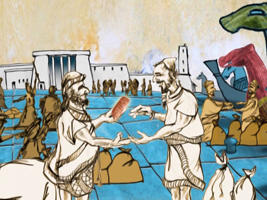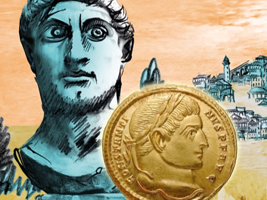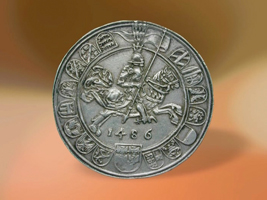When Coins Laugh and Quarrel with One Another A Trilogy
When Coins Laugh and Quarrel – The Lead Currencies
Here the first part of an exciting radio-play trilogy awaits you. It takes place in antiquity and you will hear a Cuneiform Tablet, a Croesus Stater, an Athenian Tetradrachma, a Roman Denarius and a Solidus talking about themselves. They experienced their heyday, however, at different times and in different places. But for once they appear together.
Listen to what these coins have to report to you. Eavesdrop on their stories of battles fought and triumphant conquests, of successes and defeats.
Roles:
- Speaker
- Assistant Director
- Cuneiform Tablet
- Roman Denarius
- Tetradrachma
- Solidus
- Croesus Stater

What we burn onto CDs today was scratched in cuneiform script into small soft clay tablets in ancient Mesopotamia, present-day Iraq. And the information on the so-called cuneiform tablets was just as varied as the files on a CD-ROM: deliveries of grain, government decisions, administrative matters, treaties and religious affairs were recorded on them. And when it was a matter of especially important questions the signature was added: then the customer pressed his seal onto the tablet. When the business transactions had been concluded, the less important clay tablets landed on the refuse heap. Important information, on the other hand, was fixed by firing the clay tablets and then depositing them in large archives. Because the manner of safeguarding information was so practical, the cuneiform tablets quickly found imitators: they served as a medium for storing information from the south of Iraq to Anatolia. The cuneiform writing−developed by the Sumeri- ans in about 3200 BC and one of mankind’s oldest scripts−and the clay tablets were used as storage media for more than two and a half millennia. Whether our CD-ROMs are also destined to live that long?
Coins minted out of precious metal in Asia Minor, present-day Turkey, and on the offshore islands had been known for quite some time. They were used as sacrificial offerings to the gods, as precious gifts and as a space-saving way of keeping valu- ables. But their great metal value also had its drawbacks−much the same as if today there were only notes worth thousands. Smaller amounts could only be paid for with tangible assets, such as, for example, cattle and grain−or slaves. Under these conditions trade could only boom to a certain extent. But every- thing changed when the first currency system in the world was developed under King Croesus (c. 560−546 BC). Now there were not only large denominations, but also small coins, in silver and gold. It is obvious that this gave an enormous impetus to trade. And it is also obvious that this brilliant idea has been copied everywhere−right up to the present time.

In the beginning, in the 6th century BC, the Athenian drachm was just a coin like many others: a city stamp with the head of the godess Pallas Athena on the obverse and an owl, the animal that accompanied wise Athena, on the reverse. There was nothing to indicate that this would change one day. Until the day when in the year 480 BC the allied Greek city states succeeded in holding up Xerxes’ march and thus the Persian advance. Suddenly everything looked quite different: the seas were free, trade and, with it, the Delian League flourished. Athens, which had managed to impose tributes on a number of Greek cities, was deeply invol- ved in the business: huge quantities of taxes now poured into Athens in the form of silver coins. There they were melted down and the metal was minted as Athenian tetradrachms. Millions of drachms and tetradrachms were produced in this way. As a result of the constant flow of money, Athens naturally prospered very considerably, the city was immensely rich−and soon excessively arrogant as well: it engaged in ill-considered military experiments, continually losing tributary cities to Sparta. Around 400 BC Athens’ fate was finally sealed. Sparta won the Peloponnesian War−and the «Athenian owls,» as Athens’ coins were called, had also passed their zenith.

Solidus. The name says it all, there was something solid behind it. That was also what was desperately needed, as the Roman Empire had been in a deep economic and power crisis for almost 50 years. Emperor Diocletian (284−305) carried out the necessary preparatory work to put an end to the malaise in the empire. In his choice of the means to do so he was not especially sque- amish. The same also applied to his successor, Emperor Constantine. He, ho- wever, as he did not persecute the Christians, unlike his predecessor, but even converted to Christianity, was to go down in history as the favourite child of Western historians. In his long reign Constantine actually did achieve quite a lot: with the solidus he put a gold coin on the market which justified its name. Thus the currency was at last stabilised, inflation curbed and trade stimulated. But even a Constantine could only delay, but not permanently stop, the decline or the later division of the empire into the Western and Eastern Empires. How Constantine set his priorities can be seen from his choice of Constantinople as the capital of the empire. The shift of the centre of power away from the West, Rome, to the East, Constantinople, is programmatically illustrated on the reverse of this solidus: Roma, the goddess and patron saint of the city of Rome, hands over the globe to Constantine.
Here we bring you the second part of this exciting radio-play trilogy. It takes place in the Middle Ages and gives voices to one of Charlemagne’s pfennigs, a Gros, an Augustalis, a Florin and a Rheingulden, the Rhenish florin...
Roles:
- Speaker
- Assistant Director
- Gros tournois
- Augustalis
- Florin, or Fiorino d’oro
- Charlemagne’s Pfennig
- Rheingulden

Here we present the third part of this exciting radio-play trilogy. It takes place in modern times, and you will hear a Guldiner, a Peso, a Maria Theresa Thaler, a Dollar and a Euro reporting on their individual features ...
Roles:
- Speaker
- Assistant Director
- Guldiner
- Euro
- Maria Theresa Thaler
- Dollar
- Peso

If Archduke Sigismund had foreseen what a splendid future on this and the other side of the Atlantic was awaiting the large silver coin he had just created, he would no doubt have put an even more fanciful helmet-plume on his head. But in 1486, when Sigismund created his gulden- groschen or guldiner−that was the official name of this newcomer−America had, of course, not yet been discovered. But even without America it was all go in old Europe at that time: the recently discovered deposits of silver ore on his territory allowed Sigismund to have Europe’s first large silver coin minted. Sigismund's nickname «the Rich» is worth more than a thousand words in this context. If, however, the Rich had only lived 20 years longer he could have witnessed the actual triumphant advance of his creation. For in 1520 the Bohemian counts Schlick minted huge quantities of guldengroschens using silver from the valley called Joachimsthal, which on account of their provenance were called Joachimsthaler. But lazy as people are in their speech, they soon abbreviated this long name: the thaler, one of the most successful coins in history, had finally been born.

The obverse sides of the euro coins and euro cents are indeed not brilliant works of art compared with the old coins. But the most important currency reform of our times offers other advantages: since January 2002 you can pay with the euro in most of the countries in the European Union, which is extremely practical for anyone who travels a lot. But that was not the principal reason for creating the euro. In a united currency area there are, as everyone knows, no currency risks. The euro should in future, that is the ambitious goal of its spiritual fat- hers, rather become a counterweight to the domi- nant dollar and, above all of course, stimulate trade inside the EU.